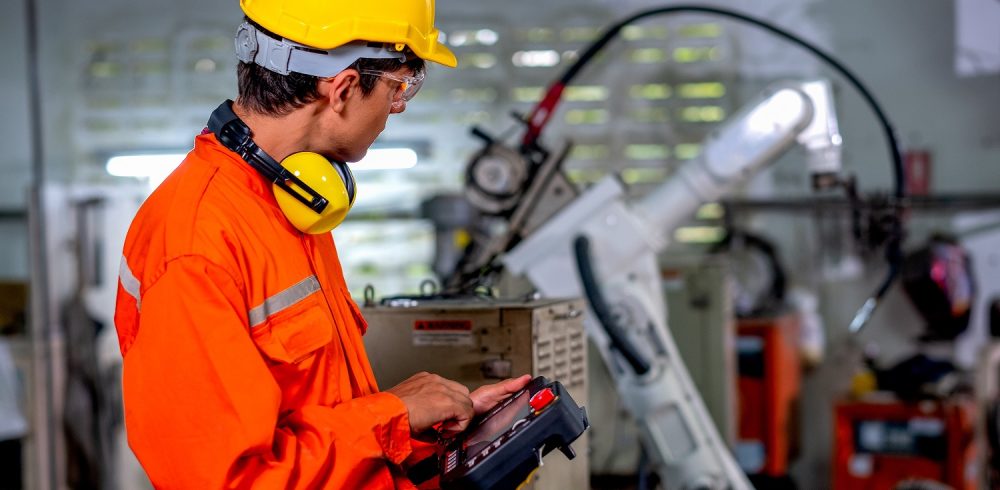Automation, robotics, and related digital trends have expanded throughout manufacturing for some years and are on the rise more than ever before. By adopting innovations on the manufacturing floor, manufacturers have optimized many parts of their operations, including product quality, line efficiency, and worker safety, to name but a few.
Uses of robotics in maintenance management
Keeping processes and machinery running in optimal condition requires a strategic mix of scheduling and planning and effective allocation of resources. But even after abiding by the above protocol, industrial equipment will still break down one day. As one might expect, all this makes maintenance management costly, at times dangerous, and time-consuming. So, why should companies invest in robotics to help manage maintenance and repairs?
- Improved safety: Robots can work in hazardous environments to that would be dangerous for humans. Robots can complete these hazardous tasks with little to no damage to themselves.
- Optimal accuracy. Robots ensure a certain quality and precision that human labor wouldn’t achieve continuously for long periods. They can yield these results with very few mistakes if any.
- Longer hours. For recurrent maintenance tasks, robots allow scheduling the tasks to run for many hours without recesses.
- Robotic processes can be re-tooled, repurposed, and reprogrammed for different uses.
Automation in maintenance management
Most automation in maintenance management is the exclusive result of software support. To increase the advantages of industrial maintenance, Computerized Maintenance Management Software (CMMS) and additional solutions have concentrated on automating tasks such as preventive maintenance scheduling, various aspects of asset management, and spare-parts inventory forecasts.
Along with sensors, this notion can be taken further. When a sensor meets a predetermined threshold, CMMS solutions with proper integrations, can automatically issue and emit instant alerts and schedule work orders.
Let’s look at these advantages in more detail:
- Automation influences an organization by increasing productivity. How? Repetitive tasks that require little skill can be automated and eliminated from a technician’s workload. Simple things, like vibration checks, oil sampling, and meter reading, can all move to automated states without much effort. The goal is to make better use of technician capability. As a matter of fact, automation can create opportunities for workers as it allows them to enhance their skills by focusing on more complicated issues. In addition, automated tasks are exempt from human errors and reduce the situation where a specific maintenance task has to be repeated because technicians did it improperly.
- Through automation, most maintenance tasks can be made safer or replaced entirely. This mainly includes remote inspections, which can be completed through mechanical methods. Consider, for example, internal tank inspections. These are very dangerous and time-consuming as preparations to enter safely are essential. An automated process is thus advantageous here. Moreover, by automating preventive maintenance tasks with a cloud-based maintenance solution, maintenance managers can make sure it is completed. Improved PM compliance equals improved running of equipment and decreased breakdowns.
- Another way that automation can improve maintenance management is through the optimized use of data. There are multiple positive outcomes of using CMMS software to manage and automate a maintenance program.
- Firstly, maintenance jobs scheduling can be semi-automated. This is based on the data from sensors that do condition monitoring, and that is installed on critical assets. For example, time-based tasks can be created automatically, and maintenance managers can set up an operation where the maintenance software can generate a work order automatically.
- Secondly, tracking completed work over the year is a whole lot simpler because a database is created of all the different work records. It thus becomes easier to understand what assets are getting the most observation and how the maintenance hours are spent. Management can create reports on operational maintenance costs, performance, and inventory stock with a few clicks. Provided with this data, maintenance managers can be more sure about their decisions.
- Thirdly, history about maintenance is stored and can be accessed very quickly with software. Maintenance technicians can use this data to their advantage. They can promptly find out what happened last time the equipment was fixed and use this data to guide their decisions. Without CMMS software, this information can get forgotten or lost.
- Access to condition-monitoring data has allowed the evolution of predictive analytics. This data is used to create algorithms that can predict, with incredible accuracy, when a part will fail. This influences the maintenance department in two significant ways:
- The amount of unnecessary maintenance is significantly reduced, which reduces the overall maintenance workload.
- It demands that maintenance technicians and managers gather new skills to optimize their predictive maintenance programs and condition-monitoring machinery.
Industrial automation and robotics are influencing the global economy. The entry barriers to implementing automation are lower than ever –and thus, accessibility is enabled into all operational areas. As one might expect, this involves the maintenance department. Automation has influenced maintenance departments by improving overall data management, productivity, and safety.
Manufacturing & Engineering Magazine | The Home of Manufacturing Industry News















